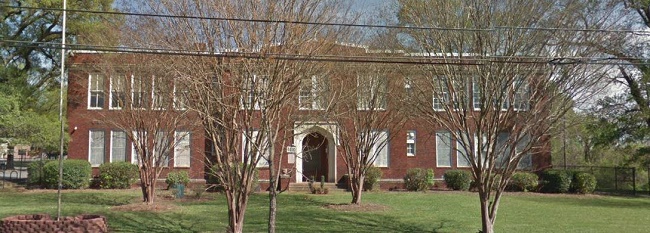September 26, 2018 – 8:00 a.m.
1. Chair’s Report: Garrett Nelson
2. Director’s Report: Dan Morrill
3. Senior Preservation Planner’s Report: Stewart Gray
4. COA Application for the Parks Hutchison School, 1400 N. Graham Street, Charlotte
Click Here for Map of Property

Parks Hutchison School
Click Here for Proposal and Plans
The applicant is proposing a new HVAC system that would require replacing some original windows with HVAC grills, and the addition of free-standing HVAC units in the first and second stories.
Staff believes that the proposed plans are not appropriate and that the proposed plans do not meet the following Secretary of the Interior’s Standards for Rehabilitation:
2. The historic character of a property shall be retained and preserved. The removal of historic materials or alteration of features and spaces that characterize a property shall be avoided.
5. Distinctive features, finishes, and construction techniques or examples of craftsmanship that characterize a historic property shall be preserved.
9. New additions, exterior alterations, or related new construction shall not destroy historic materials that characterize the property. The new work shall be differentiated from the old and shall be compatible with the massing, size, scale, and architectural features to protect the historic integrity of the property and its environment.
5. COA Application for Edgewood Plantation, 11132 Eastfield Road, Charlotte
Click Here for Map of Property

Edgewood Plantation
The applicant is proposing a development plan for the property that would preserve the property as an active farm. Additions to the property would include a gravel parking area and an approximately 5,000 square foot open pavilion.
Below is an image of a pavilion with similar design and materials to the proposed pavilion.

Example of Edgewood Pavilion Finishes
Staff believes that the proposed concept for the development of the Edgewood Plantation meets the Secretary of the Interior’s Standards 2, 9, and 10, and is an appropriate rehabilitation of the property. The impact of the proposed pavilion would be mitigated somewhat by its simple form and rustic style. Staff recommends that an approximately 5,000 sq/ft open pavilion and a gravel parking area, with approximate locations shown on the site plan, be conceptually approved, with the understanding that detailed plans will be submitted to the HLC as part of a COA application.
6. Request for a Revision to the Approved Plan for the Delburg Mill House, 303 Delburg Street, Davidson
Click Here for Map of Property

Delburg Mill House
The applicant is requesting a revision to the approved porch railing design.
Click Here for the Approved Plans
The property owner is requesting permission to construct a porch railing similar to the image below, with or without the box-feature near the top of the railing.

Porch Railing Proposal for Delburg Mill House
Staff believes that the proposed change to the approved plans for the property is not appropriate and that the proposed plan does not meet the following Secretary of the Interior’s Standards for Rehabilitation:
2. The historic character of a property shall be retained and preserved. The removal of historic materials or alteration of features and spaces that characterize a property shall be avoided.
3. Each property shall be recognized as a physical record of its time, place, and use. Changes that create a false sense of historical development, such as adding conjectural features or architectural elements from other buildings, shall not be undertaken.
7. Old Business
8. New Business
Secretary of the Interior’s Standards for Rehabilitation
“Rehabilitation” is defined as “the process of returning a property to a state of utility, through repair or alteration, which makes possible an efficient contemporary use while preserving those portions and features of the property which are significant to its historic, architectural, and cultural values.”
1. A property shall be used for its historic purpose or be placed in a new use that requires minimal change to the defining characteristics of the building and its site and environment.
2. The historic character of a property shall be retained and preserved. The removal of historic materials or alteration of features and spaces that characterize a property shall be avoided.
3. Each property shall be recognized as a physical record of its time, place, and use. Changes that create a false sense of historical development, such as adding conjectural features or architectural elements from other buildings, shall not be undertaken.
4. Most properties change over time; those changes that have acquired historic significance in their own right shall be retained and preserved.
5. Distinctive features, finishes, and construction techniques or examples of craftsmanship that characterize a property shall be preserved.
6. Deteriorated historic features shall be repaired rather than replaced. Where the severity of deterioration requires replacement of a distinctive feature, the new feature shall match the old in design, color, texture, and other visual qualities and, where possible, materials. Replacement of missing features shall be substantiated by documentary, physical, or pictorial evidence.
7. Chemical or physical treatments, such as sandblasting, that cause damage to historic materials shall not be used. The surface cleaning of structures, if appropriate, shall be undertaken using the gentlest means possible.
8. Significant archaeological resources affected by a project shall be protected and preserved. If such resources must be disturbed, mitigation measures shall be undertaken.
9. New additions, exterior alterations, or related new construction shall not destroy historic materials that characterize the property. The new work shall be differentiated from the old and shall be compatible with the massing, size, scale, and architectural features to protect the historic integrity of the property and its environment.
10. New additions and adjacent or related new construction shall be undertaken in such a manner that if removed in the future, the essential form and integrity of the historic property and its environment would be unimpaired.
